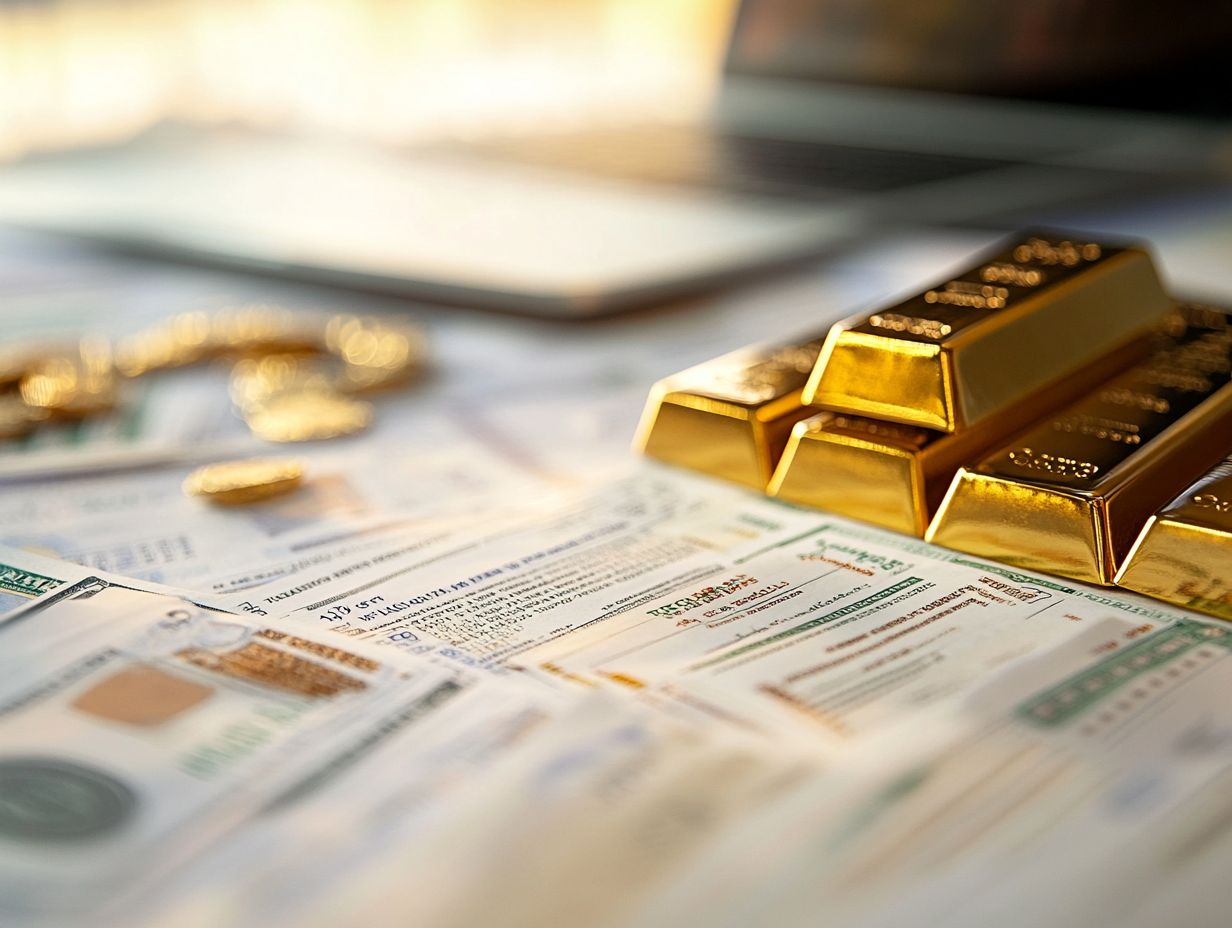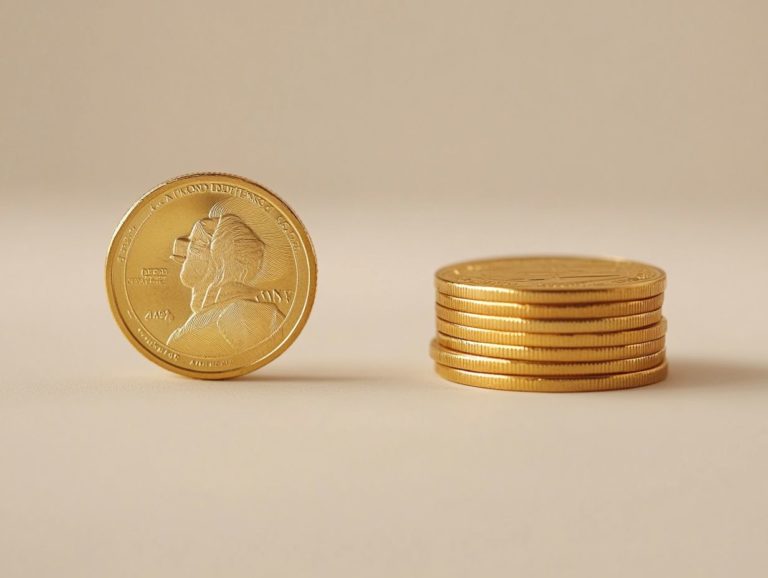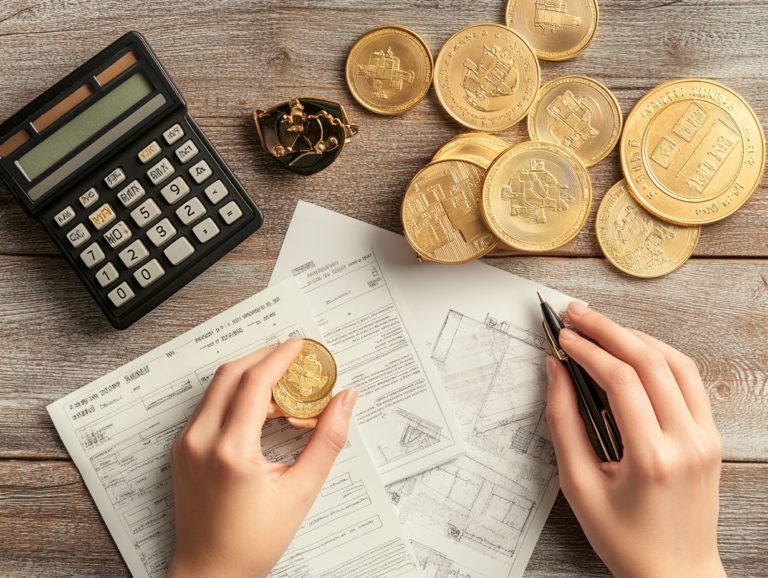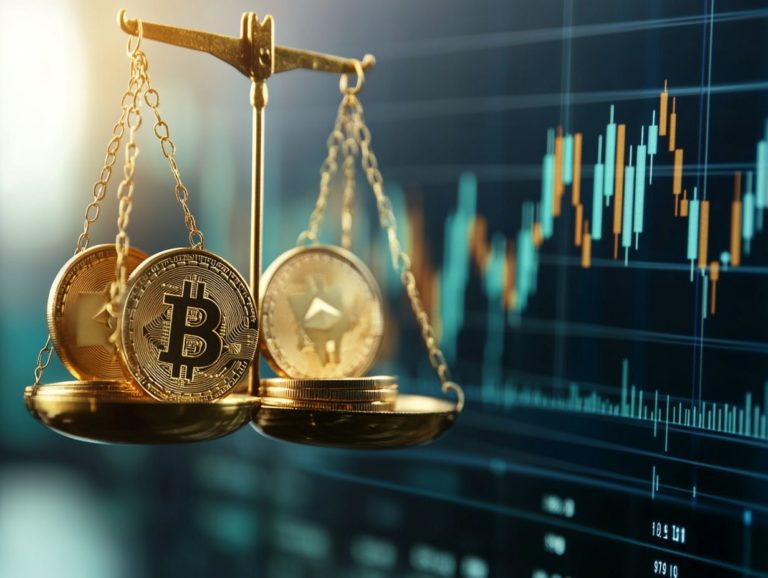How to Create a Balanced Portfolio: Physical vs. Paper
In today’s dynamic financial landscape, crafting a balanced portfolio is essential for securing your financial future.
This article delves into the vital elements of portfolio diversification, comparing tangible assets like real estate and precious metals with paper assets such as stocks and bonds. It examines the unique advantages of each category, offers strategies for effectively blending them, and underscores key factors to consider based on your personal financial goals.
Whether you re a seasoned investor or just beginning your journey, this guide will provide you with the insights necessary to make informed decisions and confidently navigate your financial path.
Contents
- Key Takeaways:
- Understanding Portfolio Diversification
- Physical vs. Paper Assets
- Benefits of Physical Assets
- Benefits of Paper Assets
- Creating a Balanced Portfolio
- Factors to Consider When Choosing Assets
- Frequently Asked Questions
- 1. What is a balanced portfolio and why is it important?
- 2. What are physical assets and why should they be included in a balanced portfolio?
- 3. What are paper assets and why should they be part of a balanced portfolio?
- 4. How should one determine the right balance between physical and paper assets in a portfolio?
- 5. Can a portfolio be too heavily weighted towards one type of asset?
- 6. Should a balanced portfolio be regularly reviewed and adjusted?
Key Takeaways:

- Diversify your investments! A balanced portfolio consists of a mix of physical and paper assets to minimize risk and maximize returns.
- Embrace physical assets for tangible value and security, while utilizing paper assets for liquidity and flexibility. Both play vital roles in a well-rounded portfolio.
- When creating a balanced portfolio, consider your personal goals and carefully assess the risk (the chance of losing money) and return potential (expected earnings) of each asset type.
Understanding Portfolio Diversification
Understanding portfolio diversification is essential for you as an individual investor aiming to manage risk while enhancing your financial returns. A well-diversified portfolio allows you to spread your investments across various asset classes think stocks (equities), bonds, commodities, and real estate thereby mitigating the impact of market volatility (fluctuations in market prices).
This strategy isn t just about chasing long-term growth; it s also about minimizing potential losses during unpredictable economic downturns. By working with financial advisors and carefully assessing your risk tolerance, you can easily create a balanced portfolio that aligns with your investment horizon and overall financial aspirations.
What is a Balanced Portfolio?
A balanced portfolio is your secret weapon for financial success, designed to blend various asset classes for optimal returns while effectively managing risk.
By diversifying your investments across stocks, bonds, real estate, and commodities, you can potentially enhance your overall financial performance. Each asset class plays a distinct role: for example, stocks may provide growth opportunities, while bonds offer stability and income. Including real estate can protect you against inflation, and commodities often serve as a safe haven during economic downturns. Understanding the importance of asset location can further optimize your investment strategy.
It s crucial to tailor this diverse strategy to your personal risk tolerance. If you have a high risk appetite, you might gravitate towards equities, whereas conservative investors may choose to allocate more to bonds to keep volatility at bay.
Physical vs. Paper Assets
Understanding the distinction between physical and paper assets is crucial for you as an investor. Each type presents its own set of benefits and risks, profoundly influencing your overall portfolio performance.
Definition and Examples
Physical assets, such as gold and real estate, are tangible goods that you can hold in your hands, while paper assets comprise financial instruments like stocks (equities), ETFs (exchange-traded funds), and bonds.
Both categories play distinct yet complementary roles in your investment portfolio. Physical assets, with their intrinsic value (inherent worth), have the potential to appreciate over time and serve as a hedge against inflation. To understand how to invest wisely, consider examples like owning a piece of land, which not only allows for rental income but also positions you for capital growth (increase in property value) as property values rise. For more insights, check out how to invest wisely: physical vs. paper.
On the other hand, paper assets tend to be more liquid (easily tradable), enabling you to buy and sell quickly, which is particularly attractive if you wish to capitalize on market fluctuations.
While stocks can provide dividends (payments to shareholders) and bonds may offer fixed interest (set earnings), they do come with their fair share of risks, including market volatility and the potential loss of principal. Grasping these distinctions is crucial for effective financial planning, helping you navigate the investment landscape with confidence.
Start diversifying your portfolio today to secure a brighter financial future!
Benefits of Physical Assets

Physical assets provide you with numerous advantages, such as tangible value that you can see and touch. They act as a safeguard against inflation, preserving your purchasing power over time.
These assets also serve as a reliable refuge during economic downturns, offering stability when markets become volatile.
Tangible Value and Security
Investing in physical assets offers you tangible value, providing a sense of security and a direct connection to your wealth.
Think of real estate, precious metals, and collectibles as your wealth-building superheroes! You may find reassurance in owning something concrete, which fosters a sense of stability and confidence.
The act of nurturing and maintaining these physical items whether it s a home, a vintage car, or a cherished art piece can significantly enhance your emotional well-being.
This emotional connection often leads to a stronger financial commitment, as you re more inclined to protect and grow your investments when you feel personally invested.
As a result, the mental benefits of ownership can guide you toward a more holistic approach to achieving financial security.
Benefits of Paper Assets
Paper assets present distinct advantages, including liquidity and flexibility, which render them a compelling option for discerning investors like yourself.
Liquidity and Flexibility
One of the significant benefits of paper assets is their liquidity, giving you the power to swiftly buy or sell investments as market conditions shift.
This characteristic is particularly vital during periods of economic uncertainty, where the ability to execute fast trades can lead to timely and strategic decisions.
Don t miss the chance to capitalize on sudden market fluctuations! You can reposition your portfolio to mitigate risks or seize emerging opportunities.
This flexibility not only supports a responsive investment approach but also creates an environment where adjustments can be made without significant delays, ultimately enhancing overall market efficiency.
In these turbulent times, having access to liquid assets allows you to adopt a more dynamically and adaptive strategy, which is crucial for navigating the unpredictable financial landscape.
Creating a Balanced Portfolio
Creating a balanced portfolio demands a meticulous approach to asset allocation. This is how you spread your investments across different types of assets to lower risk. You need to ensure diversification across various investment classes, allowing you to manage risk while optimizing your returns.
Strategies for Combining Physical and Paper Assets

Combining physical and paper assets in your investment portfolio demands a strategic approach to achieve effective diversification and manage risk.
You can explore various methods to seamlessly integrate these asset types, carefully considering factors such as liquidity, market volatility, and your personal risk tolerance.
By analyzing the potential correlations between physical assets like real estate or commodities and paper assets such as stocks and bonds, you can craft a balanced portfolio designed to maximize returns while minimizing exposure to downturns.
Staying informed about market conditions and aligning your investments with your individual goals allows you to create a more tailored strategy, ensuring that your portfolio remains resilient in the face of ever-changing economic landscapes. To make informed decisions, consider exploring the differences between physical vs. paper silver for your investment strategy.
Factors to Consider When Choosing Assets
When selecting assets for your investment portfolio, it’s essential to consider a range of factors. Your individual risk tolerance, potential returns, and personal financial goals should all guide your decisions.
Each element plays a crucial role in crafting a portfolio that aligns with your unique financial aspirations.
Risk, Return, and Personal Goals
Understanding the relationship between risk and return is essential for aligning your investments with your personal goals and financial horizons. The interplay between these two factors profoundly shapes your approach to asset selection. This means you need to think about how much risk you can handle while striving for growth and managing the potential for losses.
It’s important for you to recognize that higher potential returns often come with increased risk, prompting you to carefully evaluate your own comfort with uncertainty. Financial planners are invaluable in this journey, assisting you in defining realistic goals that resonate with your investment timeline, especially when considering physical vs. paper investment in platinum.
By utilizing tools like risk assessment questionnaires and portfolio simulations, these professionals can craft strategies that reflect your financial aspirations while respecting your comfort levels and timelines. For those interested in investment strategies, exploring how to diversify: physical vs. paper metals can be beneficial.
Frequently Asked Questions
1. What is a balanced portfolio and why is it important?
Why is this important? A balanced portfolio refers to a mix of different types of investments, such as physical assets and paper assets. This diversification helps you reduce risk and maximize returns, allowing you to weather market fluctuations and protect against potential losses.
2. What are physical assets and why should they be included in a balanced portfolio?

Physical assets are tangible investments, such as real estate, precious metals, and collectibles. They provide stability and can act as a hedge against inflation. Including physical assets in a balanced portfolio helps mitigate risk and adds another layer of diversification.
3. What are paper assets and why should they be part of a balanced portfolio?
Paper assets are financial investments, such as stocks, bonds, and mutual funds. They offer liquidity and the potential for higher returns but also come with higher risk. Including paper assets in a balanced portfolio helps balance out the risk and increase your potential for growth.
4. How should one determine the right balance between physical and paper assets in a portfolio?
The allocation of physical and paper assets in a portfolio will depend on your risk tolerance, investment goals, and time horizon. Generally, a younger investor can afford to have a higher percentage of paper assets, while an older investor may lean more towards physical assets for added stability.
5. Can a portfolio be too heavily weighted towards one type of asset?
Yes, a portfolio that is heavily weighted towards one type of asset can be risky. For example, if you invest too much in stocks, your portfolio may become volatile and prone to significant losses during a market downturn. It’s crucial to maintain a balanced mix of assets to hedge against potential losses.
6. Should a balanced portfolio be regularly reviewed and adjusted?
Don’t wait! It is important to regularly review and adjust a balanced portfolio. Market conditions and your financial goals may change over time, and adjustments may need to be made to maintain the desired balance between physical and paper assets. It is recommended to check your portfolio at least once a year.















